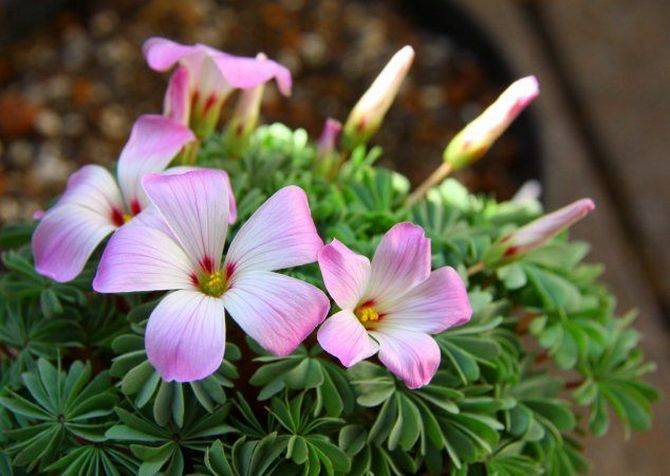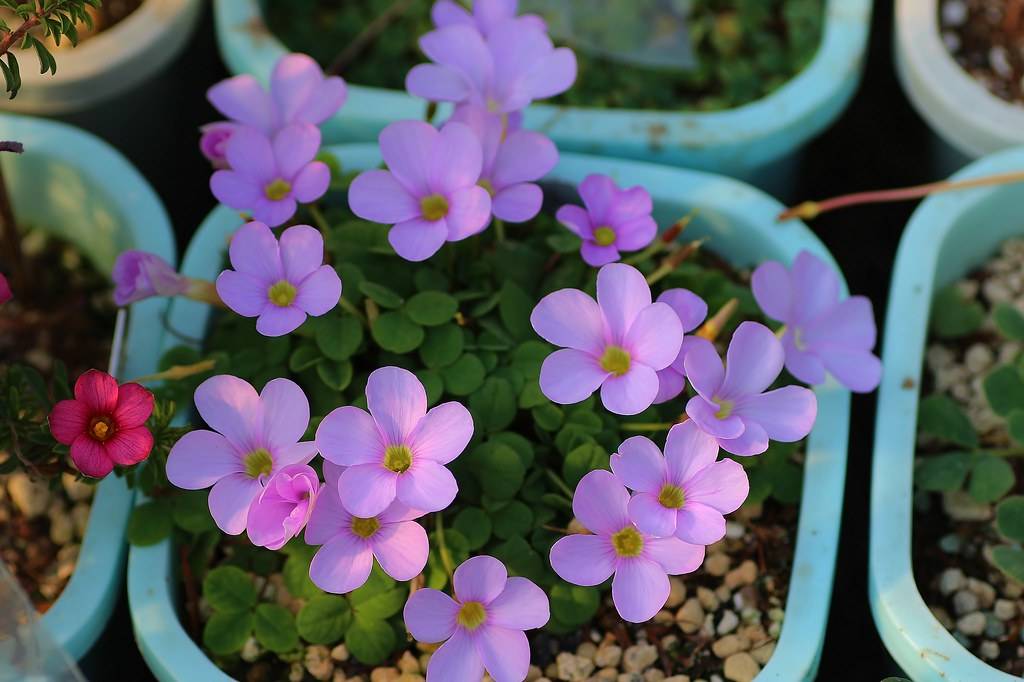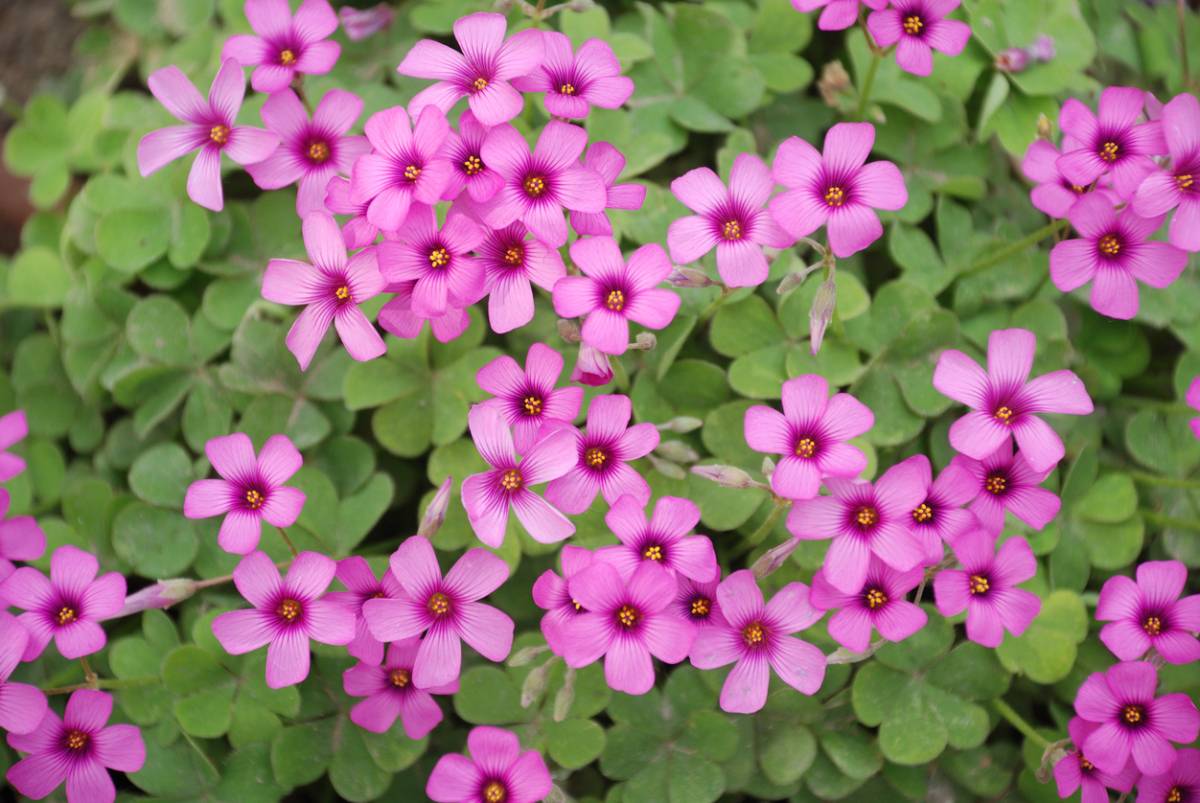Room acid - how to grow at home
Content:
A completely unpretentious, but very common plant, oxalis, attracts the attention of fans of decorative floriculture. It is also grown in the garden. Quite often you can find wild oxalis in the forests - the flower is very simple and does not stand out in any way, but there is nothing superfluous in nature.
Room oxalis - what kind of flower
For the very interesting shape of the leaves, the sorrel was nicknamed the butterfly. The flower belongs to the Acid family of over 800 different subspecies. The large amount of oxalic acid and vitamin C in the leaves imparts a specific flavor. People have noticed this long ago, hence the origin of the name.
Varieties
Indoor purple oxalis (Oxalis triangularis) is the most common indoor species. Triangular oxalis (this is the second name of the variety) are 25-35 cm high and have large purple leaves. Small pink and white flowers appear already in spring, their number is from 5 to 8 pcs. in the inflorescence. Violet oxalis has a frost-resistant variety - Regnella, or moth oxalis.
The cupped sour cherry has light green leaves and dark pink flowers. Florists consider it a novelty, although the description was presented long ago by the Scottish physician and plant collector D. Gill (1792-1834).
The homeland of the sorrel is the South American countries of Chile and Argentina. The appearance resembles a clover: small, palm-complex leaves of a silvery-green color are combined with pink and lilac flowers. Florists know this plant as the silver shamrock or Chilean oxalis.
Purple oxalis has an unusual shape and color: against the background of dark purple triangular leaves, a snow-white inflorescence looks very delicate. Burgundy oxalis grows compactly and bush luxuriantly, the height of the stems is no more than 25 cm. Leaf plates are located on thin petioles, the color is more often two-color. The edge is bordered by a dark purple, almost black, wide stripe, the middle is slightly lighter.
Growing oxalis at home
In order for the flower to retain its freshness, the acidic needs proper care at home. It is not difficult and does not take a lot of time. Flower pots should be placed on windowsills with diffused lighting. It is advisable to cover the window with a protective screen from direct scorching rays.
Since the homeland of oxalis is warm countries, the very fact suggests that when leaving and breeding, he needs warmth and light. Although the oxalis is not very capricious, non-observance of the regime has a detrimental effect on the appearance.
If possible, it is advisable to place flowerpots in the south or west side of the room, if possible. If the potted windows face north, you will need an additional light source.
Depending on the lighting, the color of the leaves may change. If the sun is not enough, the leaves turn pale and the dark edging can be lost. In addition, a green tint appears.
Oxalis care
Maintaining a moderate temperature in the summer, and this is not higher than 25°C, and in winter from 12°From to 18°C, will allow the plant to feel at ease. It is impossible for the direct rays of the sun to fall on the leaves. Oxalis don't like it. Diffused lighting provides ideal conditions.
To keep the plant fresh and pleasing to the eyes of others, it is necessary to provide at least minimal care.
- Regular watering will prevent the soil from drying out, because in the absence of moisture, the plant may die.
- In spring and summer, it is advisable to spray the leaves; it will not be superfluous to feed the plant with mineral fertilizers. This should be done from the beginning of April to the end of August. The frequency of application is once every two to three weeks.
- To keep the plants looking well-groomed, you need to remove dried flowers and leaves.
Room acid loves moderate humidity. In hot weather, pots with plants should be sprinkled daily with water. Watering should be done at least two to three times a week. This is best done with a small, long-nosed watering can. Water should be poured under the base of the stems.
Good soil is very important for acid sour, but you should not get too carried away with fertilizers. You need to treat this process with caution. If you overdo it too much, you can slow down the flowering. For example, for a triangular acidwood, an excess of nutrients will cause an increase in deciduous mass, that is, fertilization will provoke bushiness, but flowering will be very poor, or the plant may not bloom at all.
Caring for sour during the rest period
In winter, the oxalis houseplant begins to wilt and shed its leaves. This happens from December to February. Oxalis has a rest period at this time, and care during this period is slightly different from what was during the active phase. You need to prune the bush by 1-2 cm and put the pot in a dry, dark place with a low temperature, for example, a cellar or basement. Watering and feeding for this time must be stopped and resumed after a month or two, when the first shoots appear. Careful observation of the plant will prevent the appearance of harmful insects.
Drainage is needed so that water does not stagnate. This avoids some of the problems caused by over-watering. You can buy a ready-made substrate for transplanting at any flower shop or prepare it yourself by mixing equal parts of peat, river sand and humus. Some gardeners add small amounts of coconut to this mixture.
Under the right conditions, the plants thrive and the bush looks healthy and lush.
Reproduction of acid
Wild oxalis propagates by seeds on its own, but at home this method is rarely used, since there are other simpler and faster methods.
The seeds are recommended to be bought in specialized stores or harvested after flowering. For planting, soil is taken, consisting of perlite, sand and peat. Small seeds are placed on the soil surface, without falling asleep from above. Crops are carefully moistened with a sprayer. The containers are covered with plastic wrap or glass to create a greenhouse effect and placed in a place with diffused light. Recommended temperature 17°C. Planting needs to be opened and moistened every day. During the first year, small rosettes appear on the surface, the next year shoots develop from them.
The easiest way to reproduce is bulbous. The bulbs are separated from the main root, after which the seed must be planted in different containers and sprinkled with earth.The flowerpots are placed in a cool place, while the lighting should not be bright. Watering should be carried out as the soil dries up. After the first shoots appear, the pots are transferred to a bright room. After a month, bushes will grow.
The most common way to reproduce a home sorrel flower is by dividing the original plant into parts. The bushes are carefully separated, avoiding trauma to the root system. Separated rosettes with stems should be immediately transplanted into individual pots.
For propagation by cuttings, shoots of adult plants are taken, they are placed in a container with water to obtain root shoots, which can appear in 15-20 days. When the length of the shoots reaches 1.5 cm, the cuttings should be planted in pots prepared in advance with a substrate.
Diseases and pests
Kislitsa is not often sick. Usually it is resistant to various kinds of diseases. However, keeping oxalis in conditions that are not suitable for it can cause the leaves to dry out, which occurs when exposed to direct sunlight. Also, excessive watering has a detrimental effect on the root system, it can rot.
Much harm is to be expected from aphids. Known ways to deal with it:
- mechanical destruction of insects;
- the use of insecticides;
- spraying with laundry soap.
The shield brings serious damage. It is very difficult to deal with this pest due to its resistance to external influences. You can destroy the pest with your hands or carry out the treatment with alcohol or soap solution using a brush, lubricating the leaves. A toothbrush will do. This will help not only to destroy existing pests, but also become a preventive measure to prevent the reproduction of pests later.
Another insect to be afraid of is the whitefly. It can appear at elevated temperatures, stale air or highly moist soil.
Another serious problem is root decay. This can provoke intense watering. At the first signs of the disease, you need to pull the plant out of the pot, shake off the adhering soil from the rhizome and cut off the area where rot has appeared. Plant the freshened stems in fresh soil and conduct a small amount of watering to adapt and restore the roots.
Diseases for such an unassuming plant as oxalis are a rather rare phenomenon, since it is resistant to many ailments. Illness occurs with poor care. If you follow all the recommendations, you can avoid many problems. If they do appear, an urgent need to find the cause and eliminate it.
The very conditional division of oxalis species into garden and indoor allows you to grow flowers in both conditions. In open ground, heat-loving plants need to be covered, and with indoor cultivation, these delicate bushes will delight with their beauty for a long time.






















